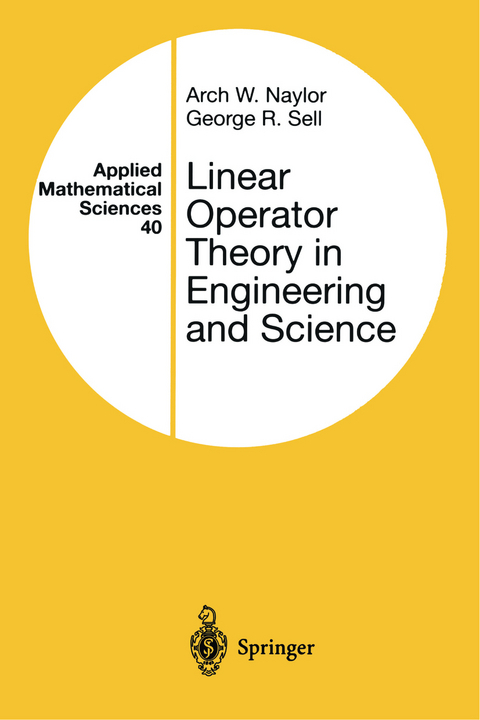Linear Operator Theory in Engineering and Science
Springer-Verlag New York Inc.
978-0-387-95001-3 (ISBN)
1 Introduction.- 1. Black Boxes.- 2. Structure of the Plane.- 3. Mathematical Modeling.- 4. The Axiomatic Method. The Process of Abstraction.- 5. Proofs of Theorems.- 2 Set-Theoretic Structure.- 1. Introduction.- 2. Basic Set Operations.- 3. Cartesian Products.- 4. Sets of Numbers.- 5. Equivalence Relations and Partitions.- 6. Functions.- 7. Inverses.- 8. Systems Types.- 3 Topological Structure.- 1. Introduction.- A Introduction to Metric Spaces.- 2. Metric Spaces: Definition.- 3. Examples of Metric Spaces.- 4. Subspaces and Product Spaces.- 5. Continuous Functions.- 6. Convergent Sequences.- 7. A Connection Between Continuity and Convergence.- B Some Deeper Metric Space Concepts.- 8. Local Neighborhoods.- 9. Open Sets.- 10. More on Open Sets.- 11. Examples of Homeomorphic Metric Spaces.- 12. Closed Sets and the Closure Operation.- 13. Completeness.- 14. Completion of Metric Spaces.- 15. Contraction Mapping.- 16. Total Boundedness and Approximations.- 17. Compactness.- 4 Algebraic Structure.- 1. Introduction.- A Introduction to Linear Spaces.- 2. Linear Spaces and Linear Subspaces.- 3. Linear Transformations.- 4. Inverse Transformations.- 5. Isomorphisms.- 6. Linear Independence and Dependence.- 7. Hamel Bases and Dimension.- 8. The Use of Matrices to Represent Linear Transformations.- 9. Equivalent Linear Transformations.- B Further Topics.- 10. Direct Sums and Sums.- 11. Projections.- 12. Linear Functionals and the Algebraic Conjugate of a Linear Space.- 13. Transpose of a Linear Transformation.- 5 Combined Topological and Algebraic Structure.- 1. Introduction.- A Banach Spaces.- 2. Definitions.- 3. Examples of Normal Linear Spaces.- 4. Sequences and Series.- 5. Linear Subspaces.- 6. Continuous Linear Transformations.- 7. Inverses and Continuous Inverses.- 8. Operator Topologies.- 9. Equivalence of Normed Linear Spaces.- 10. Finite-Dimensional Spaces.- 11. Normed Conjugate Space and Conjugate Operator.- B Hilbert Spaces.- 12. Inner Product and Hilbert Spaces.- 13.Examples.- 14. Orthogonality.- 15. Orthogonal Complements and the Projection Theorem.- 16. Orthogonal Projections.- 17. Orthogonal Sets and Bases: Generalized Fourier Series.- 18. Examples of Orthonormal Bases.- 19. Unitary Operators and Equivalent Inner Product Spaces.- 20. Sums and Direct Sums of Hilbert Spaces.- 21. Continuous Linear Functionals.- C Special Operators.- 22. The Adjoint Operator.- 23. Normal and Self-Adjoint Operators.- 24. Compact Operators.- 25. Foundations of Quantum Mechanics.- 6 Analysis of Linear Operators (Compact Case).- 1. Introduction.- A An Illustrative Example.- 2. Geometric Analysis of Operators.- 3. Geometric Analysis. The Eigenvalue-Eigenvector Problem.- >4. A Finite-Dimensional Problem.- B The Spectrum.- 5. The Spectrum of Linear Transformations.- 6. Examples of Spectra.- 7. Properties of the Spectrum.- C Spectral Analysis.- 8. Resolutions of the Identity.- 9. Weighted Sums of Projections.- 10. Spectral Properties of Compact, Normal, and Self-AdjointOperators.- 11. The Spectral Theorem.- 12. Functions of Operators (Operational Calculus).- 13. Applications of the Spectral Theorem.- 14. Nonnormal Operators.- 7 Analysis of Unbounded Operators.- 1. Introduction.- 2. Green’s Functions.- 3. Symmetric Operators.- 4. Examples of Symmetric Operators.- 5. Sturm-Liouville Operators.- 6. Gårding’s Inequality.- 7. Elliptic Partial Differential Operators.- 8. The Dirichlet Problem.- 9. The Heat Equation and Wave Equation.- 10. Self-Adjoint Operators.- 11. The Cayley Transform.- 12. Quantum Mechanics, Revisited.- 13. Heisenberg Uncertainty Principle.- 14. The Harmonic Oscillator.- Appendix A The Hölder, Schwartz, and Minkowski Inequalities.- Appendix B Cardinality.- Appendix C Zorn’s Lemma.- Appendix D Integration and Measure Theory.- 1. Introduction.- 2. The Riemann Integral.- 3. A Problem with the Riemann Integral.- 5. Null Sets.- 6. Convergence Almost Everywhere.- 7. The Lebesgue Integral.- 8. Limit Theorems.- 9. Miscellany.- 10. Other Definitions of the Integral.- 13. Differentiation.- 14. The Radon-Nikodym Theorem.- 15. Fubini Theorem.- Appendix E Probability Spaces and Stochastic Processes.- 1. Probability Spaces.- 2. Random Variables and Probability Distributions.- 3. Expectation.- 4. Stochastic Independence.- 5. Conditional Expectation Operator.- 6. Stochastic Processes.- Index of Symbols.
| Reihe/Serie | Applied Mathematical Sciences ; 40 |
|---|---|
| Zusatzinfo | 22 Illustrations, black and white; XV, 624 p. 22 illus. |
| Verlagsort | New York, NY |
| Sprache | englisch |
| Maße | 155 x 235 mm |
| Themenwelt | Mathematik / Informatik ► Mathematik ► Algebra |
| Mathematik / Informatik ► Mathematik ► Analysis | |
| Mathematik / Informatik ► Mathematik ► Angewandte Mathematik | |
| ISBN-10 | 0-387-95001-X / 038795001X |
| ISBN-13 | 978-0-387-95001-3 / 9780387950013 |
| Zustand | Neuware |
| Haben Sie eine Frage zum Produkt? |
aus dem Bereich




